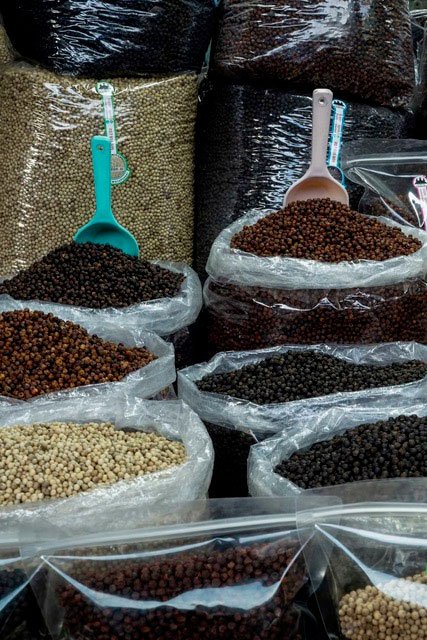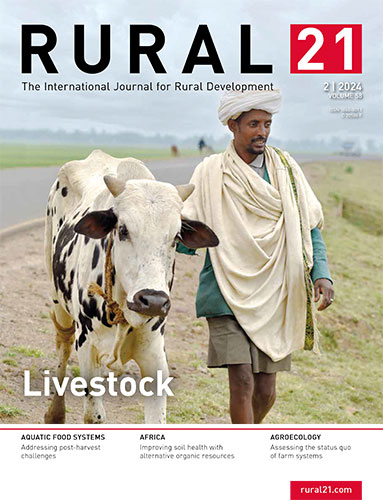 Download this article in magazine layout
Download this article in magazine layout
- Share this article
- Subscribe to our newsletter
Hot, colourful and remunerative
Chang Deang wipes his hand on his worn working trousers. He carefully takes one of the pinnacles with the green corns, plucks a number of them and lays them on the palm of his hand, from which he just got rid of the sticky reddish soil. “Try some, they’re really hot,” the farmer says with a smile on his haggard face. “We often cook using the young, green pepper,” the 67-year-old from the Cambodian province of Kampot explains. “We like it best with shrimps and rice noodles.”
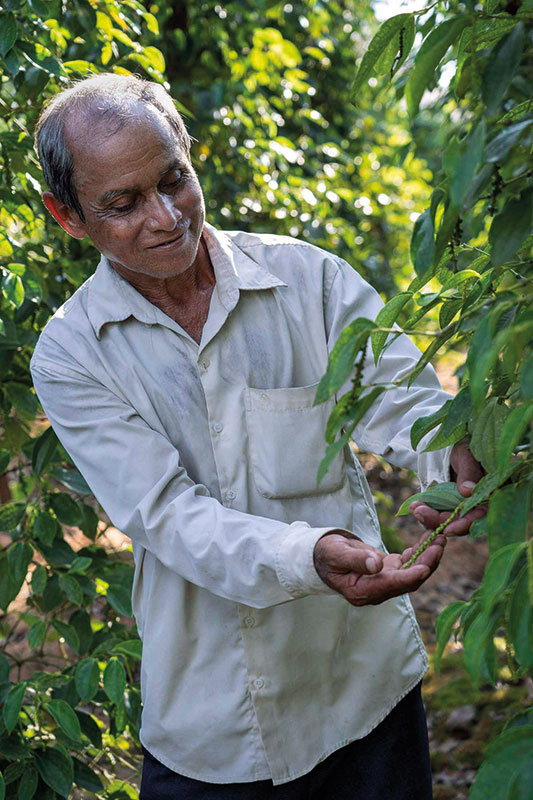
Farmer Chang Deang plucking some corns from one of his 300 pepper plants.
Photos: Martin Egbert
The heat sensation rapidly spreads throughout the entire oral cavity. But there is so much more: the taste of citrus fruits and thyme, of minerals and a bit of eucalyptus as well as fresh greens. Chang Deang watches his counterpart’s response in a friendly, quiet manner. He is aware of how special his pepper is. After all, this is the third generation of the plant he is growing. Every day, he walks along the rows of up to five-metre-tall plants two of which always wind their way around a wooden stake. Depending on the season of the year, Chang Deang prunes the plants, checks them for pests, loosens the soil and fertilises and irrigates it. “In the dry season, I have to do all that every second day. The pepper plant needs a lot of water,” Chang Deang explains. For this purpose, he has dug a pond in which he gathers the rainwater over the months. Then, between March and June, harvesting is in progress nearly every day. Together with his son-in-law and his two daughters, Chang Deang does all this exclusively by hand. This ensures the product’s high quality.
Popular with chefs and hobby cooks
Kampot pepper is said to be the best pepper in the world. Chefs and hobby cooks alike swear by this spice originating from southwest Cambodia. The quantities produced there are relatively modest. Only 300 pepper plants are growing on Chang Deang’s farm, which itself is hardly bigger than half a soccer pitch. “Last year, I was just about able to harvest 240 kilograms – and that was a good year!” he notes. The entire province of Kampot turns out an annual harvest of slightly below 80 tonnes. On average, an individual plant will yield barely more than a kilogram of pepper. By contrast, in Vietnam, at 220,000 tonnes a year the largest producer world-wide, four to five times as much can be obtained from a single plant. This low level of availability is another aspect that makes Kampot pepper so sought after.
However, its biggest asset is its special quality, which is ensured by the traditional cultivating methods of the mainly small farms, the very humid and warm climate close to the coast in the Gulf of Thailand and the soils, which are highly penetrable and rich in mineral content. Also, the pepper in Kampot often thrives on old plants which have grown very deep roots. Furthermore, chemical fertiliser and pesticides are forbidden. Chang Deang exclusively uses cow dung and guano as fertiliser. The farmers gather bat droppings with tarpaulins they spread out under the trees from which the animals are hanging. Other farmers also make fertiliser with cow dung and grinded cattle bones or prawn husks. Chang Deang keeps pests at bay with slurry made of neem or tobacco.
Most of these rules are prescribed by a set of regulations adopted by the Kampot Pepper Promotion Association (KPPA), in which nearly 350 producers from the region are organised. Only they may refer to their product as Kampot pepper. Although the relatively large La Plantation, a model farm well-known for its agro-tourism which produces roughly a third of all Kampot pepper, also belongs to the Association, the majority of the producers manage farms the size of Chang Deang’s. But how can these small farmers, many of who have had only little or even no school education and have usually never left their villages, conquer the kitchens of this world?
Market access and fair prices
This has a lot to do with Sébastien Lesieur. “I was familiar with the pepper from Kampot through my grandmother in France,” the 44-year-old Frenchman wearing round glasses and short grey hair explains, sitting at a wooden table in a villa on the outskirts of Kampot, the seat of his Social Enterprise Farmlink. Jars with red, white and green pepper are standing on the table. Tall hibiscus bushes are blossoming in front of the window, while mango and neem trees offer shade.
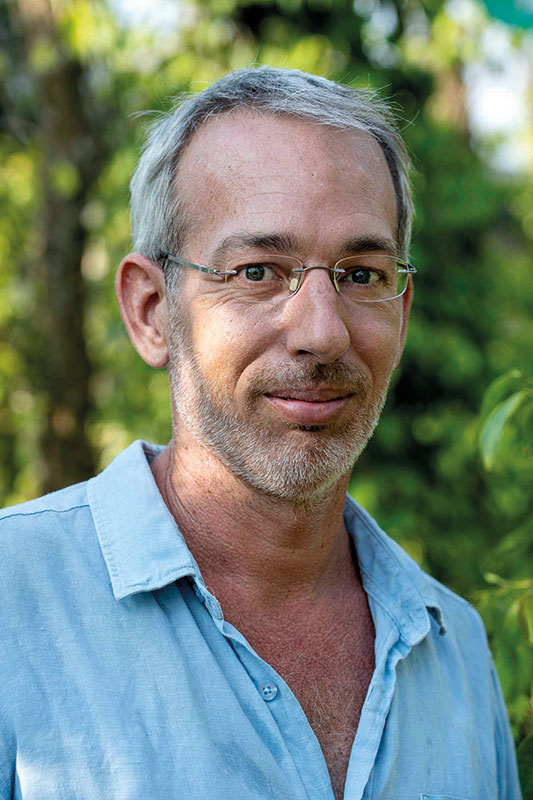
Sébastien Lesieur founded Farmlink in 2005.
Sébastien Lesieur has been living in Cambodia for more than 20 years. Before that, he had been employed as a communications technology engineer in Paris. Boredom and gloom caused him to move to Southeast Asia, where he initially worked in development cooperation in Cambodia. Then he founded Farmlink. This company processes and markets pepper from up to 80 small-scale producers from the region. It helps farmers improve cultivation and with providing finance for the harvest. But above all, it creates access to markets in Europe for them and pay a fair price. “We pay the Farmlink farmers twice as much as the other merchants and processors in Kampot and ten times as much as what a pepper farmer gets in Vietnam,” Lesieur explains.
It was also the French who, as a colonial power, introduced the cultivation of pepper in Kampot in order to meet their domestic demand. More than half of the total 8,000 tonnes of Kampot pepper harvested in the region at the beginning of the 20th century was shipped to France. There were still around a million pepper plants in Kampot in 1960. In 1975, all this met with an abrupt end when the Khmer Rouge established their reign of terror, claiming the lives of up to 2.2 million Cambodians after a long period of civil war. The pepper plantations were turned into rice paddies with forced labour, and fell into oblivion. Although the Khmer Rouge were all but ousted when the Vietnamese invaded the country, they managed to hold their own as a guerrilla army in some regions and provinces, also in the mountains of Kampot. It was not before the end of the 1990s that this small country with what are today just under 17 million inhabitants finally found peace. Since the 2000s, the revival of pepper growing has also been spreading in the province. So, founded in 2005, Farmlink was there virtually right from the start. The number of farmers represented and the quantities of pepper vary from year to year, although overall, sales have risen substantially. “Ten years ago, we still had harvests of five to six tonnes, and today we are marketing more than 20 tonnes a year,” Lesieur says. So Farmlink brings a quarter of the entire harvest from Kampot to the rest of the world. The gourmet pepper goes mainly to France and Germany, although Farmlink also sells the hot peppercorns to the USA and Australia.
Strict quality controls
No matter where the pepper is exported to, thanks to precise documentation, every margin can be traced back to the individual smallholder. Everything is meticulously processed at Farmlink. In front of Sébastien Lesieur’s office, staff are spreading out black pepper on long tables in the garden to dry it. They have previously washed it and ridden it of germs in hot water. “Steam would be too hot, and would harm the aroma,” Sébastien Lesieur explains. Drying the pepper takes several days. In the evening, the staff heap up the pepper again and store it by hand. The following day, they once more spread it out, again and again sorting out bad peppercorns.
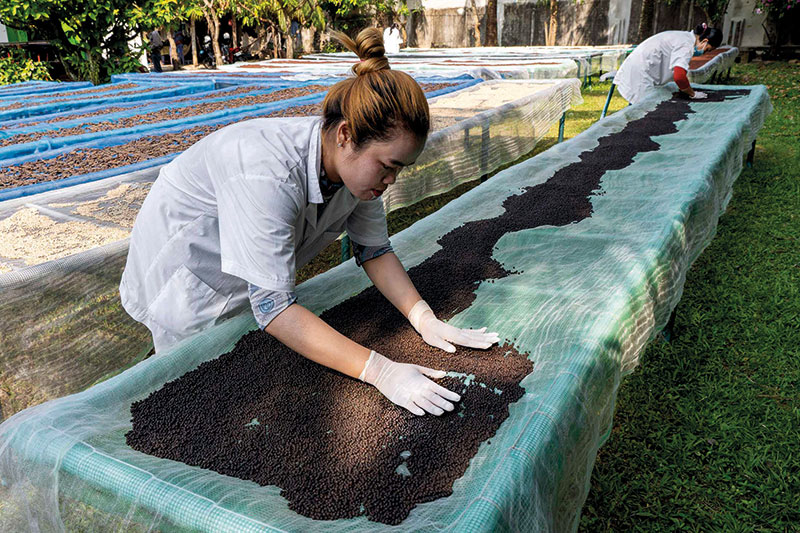
Drying the pepper takes several days. In each round, bad peppercorns are winnowed out.
When the drying is finished, before the packaging of the goods starts, there is another, final quality check. In one of the villa’s rooms, staff wearing white overalls and masks are sitting testing the corns with tweezers, with which they also clip off some of the few remaining stalks. In this manner, up to a fifth of the harvest is once again sorted during processing. Sébastien Lesieur examines a plate of black peppercorns. In Khmer, he gives instructions and cracks jokes with the staff. The atmosphere is casual, and Farmlink also pays its staff well. In addition, they only work five days a week, not the country’s usual six.
Just like with other varieties, there are three different types of pepper from Kampot. The pepper berries are ripe once their skin is coloured red in the pepper bush. If they are only harvested at this stage, their hotness will be balanced by their sweetness. Moreover, they have a fruity taste and are very suitable for salads or soups. Black pepper is gained from the green berries which are unripe when harvested, dry in the sun for some weeks and gradually change colour. This pepper tastes hot and strong, making it best suited for meat dishes. White pepper has its skin washed off, giving it a piquante, sour flavour.
Chang Deang’s farm, on which he was already working as a child, used to be situated further back in the mountains. It was destroyed by the Khmer Rouge. He would rather not go on talking about this, and prefers to recall how he took up the tradition again more than 20 years ago. Since then, things have been improving steadily, above all thanks to Farmlink. “We can pay helpers, and we have bought a motorbike, a small tractor and a pump for irrigation,” he happily says. “In addition, we have redecorated the house and bought new furniture.” The family grow rice and vegetables for their own consumption. But income is earned with the pepper. Then Chang Deang hands us a couple of green peppercorns. Pepper from Kampot does everyone good, including the smallholders. And of course it delights the taste buds.
Klaus Sieg is a freelance journalist. He writes about agriculture and food, the environment, energy, the economy and social issues. He is based in Hamburg, Germany.
Contact: klaus@siegtext.de


